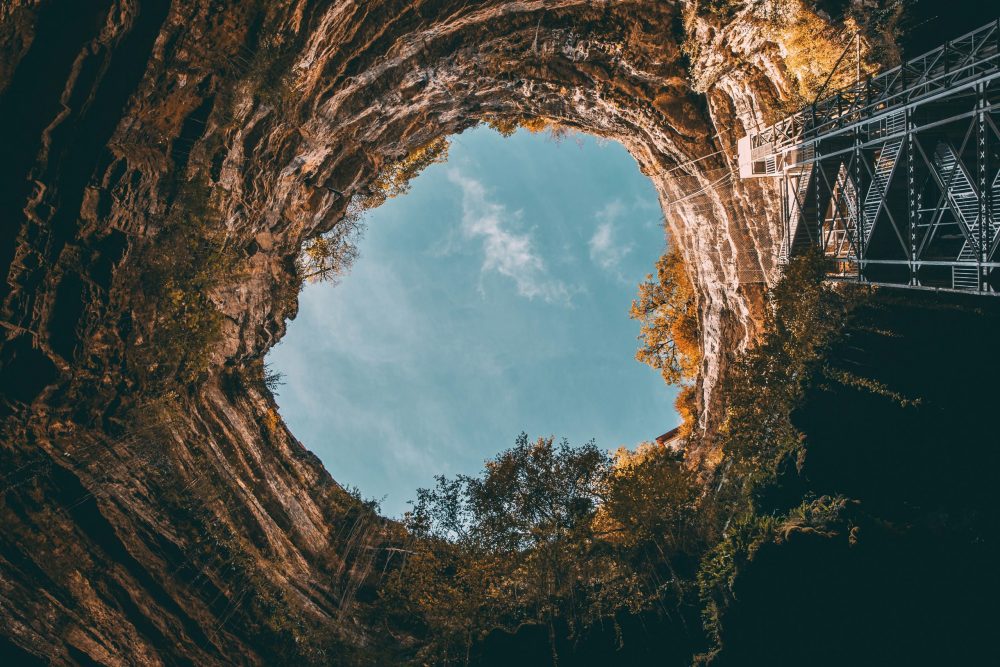Cynthia Milota, staff writer for Work Design Magazine, asks some crucial waste questions, defines the Circular Economy (CE) and why it is important now.
The Circular Economy is not about reducing waste. It is about designing a world where waste is not created in the first place.
– Ellen MacArthur Foundation
Let’s explore some real-world examples of eliminating waste.
The best answer would be “D,” that everyone in the office would fill up their re-useable water bottle, as no waste is created, and minimal energy is used in the water filtration.
Thoughts on the other potential responses:
- Recycling plastic bottles is very “cumbersome and expensive and in many cases, new ‘virgin plastics’ are cheaper than recycled plastics” (Nunez, 2021).
- Whether paper or plastic, the Environmental Protection Association (EPA) calculates that only about 32% of municipal waste is actually recycled (US EPA, 2018).
- Glassware and water pitchers are a good option, especially if people from outside the organization will be present, acknowledging that there is energy required for the water filtration and the dishwasher to clean the reusable glassware.
Here’s a tougher question.
The most circular response to this question is “D,” to plan for the furniture’s end of life, starting with the procurement process. Consider online asset tracking and sharing platforms like Reseat or Rheaply.
Circular Economy (CE) Definition

The Linear and Recycling frameworks in Figure 1 reflect the current US economic models (Jenson, 2022). Raw materials are extracted, goods are produced and used, and some recycling of materials is incorporated into the system before they become waste at the end of their usable life.
Waste is designed out in a Circular Economy. Products and materials are kept in circulation through processes like maintenance, reuse, refurbishment, remanufacture, recycling and composting (“What is the Circular Economy”, n.d.).
Opportunities to be more circular are everywhere once we reframe our waste perspective.
Instead of this… … Use this
Moving away from paper is as much a social/behavioral issue as a first cost one.
Instead of this… … Use this
Cases of water are easier than the first cost of installing a line for filtered water and purchasing glassware.
Instead of this… … Use this
Even when we ask the caterer not to bring disposable products, they often are included with the food.
Instead of this… … Use this
Many office coffee stations are not outfitted with a place to wash mugs, paper is more expedient.
Now reflect on your company’s engagement with the Circular Economy and consider the reasons.
Circular Economy Motivations
Organizations implement circular principles for various economic, environmental and social
factors. Key motivators include:
● Resource efficiency and cost reduction
● Minimize environmental impacts
● Innovative design, manufacturing and business models
● Positive brand perception with employees and customers
● Recruiting employees, by aligning with their values
● Regulatory compliance
● Risk mitigation
● Long-term business resilience
● Shareholder and Investor Relations
● Sustainable supply chain
● Ethical and social responsibility
Integrating CE practices, position organizations for sustainable, resilient and long-term success in rapidly changing global business environments.
Circular Economy Models

In “The Circular Business Model” Harvard Business Review identifies three circular business frameworks.
Retain Product Ownership (RPO): when “the producer rents or leases its products to the customer rather than selling it. Thus the producer is responsible for products when the consumer (or business) has finished with them” (Atasu, et al, 2021).
Examples include the familiar practice of leasing the office printer or renting a tuxedo. Emerging examples include furniture as a services and lighting as a service.
Product Life Extension (PLE): when “products are designed to last longer, it may open up possibilities for markets in used products” (Atasu, et al, 2021). Durability becomes a key differentiator and a reason for premium pricing.
Organizations like Patagonia, Miele and Bosch Power Tools have rejected the planned obsolescence model for their more durable, long-lasting products. Their take back and repair models keep products in service longer. The furniture industry has long incorporated remanufactured products as an option, but generally as a cost savings measure and not as a preferred choice.
Design for Recycling (DFR): “redesigns products and manufacturing processes to maximize recoverability of the materials involved for use in new products” (Atasu, et al, 2021). Partnerships between companies develop innovative ways materials can be recovered and reused.
One such partnership between Adidas and Parley for the Oceans exemplifying waste as a resource “uses plastic waste to make textile thread from which Adidas manufactures its shoes and apparel” (Atasu, et al, 2021).

Design for recycling connects intrinsically to design for disassembly. The Herman Miller Mirra chair was the first product designed from the beginning to end using the Cradle-to-Cradle protocol. The disassembly feature was used as a marketing tool. (It made an impression on me from 2004 when this image was first popularized).
Read about how to implement the circular economy in part two of the practical guide!
Implementing the Circular Economy: A Practical Guide for Impact

References
Atasu, A., Dumas, C., Van Wassenhove, L. (July-August 2021). “The circular business model,” Harvard Business Review. Retrieved from: https://hbr.org/2021/07/the-circular-business-model
Bocconi University, Ellen MacArthur Foundation, Intesa Sanpaolo Innovation Center. (2021). “The circular economy as a de-risking strategy and driver of superior risk-adjusted returns.” Retrieved from: https://emf.thirdlight.com/file/24/edqbiYMen-3CK9edru0edWuIXL/The%20circular%20economy%20as%20a%20de-risking%20strategy%20and%20driver%20of%20superior%20risk-adjusted%20returns.pdf
Deloitte. (n.d.). “Scope 1,2 and 3 emissions, what you need to know.” Retrieved from: https://www2.deloitte.com/uk/en/focus/climate-change/zero-in-on-scope-1-2-and-3-emissions.html
“Eliminate waste and pollution,” (n.d.). Ellen MacArthur Foundation. Retrieved from: https://www.ellenmacarthurfoundation.org/eliminate-waste-and-pollution
Fontrodona, J. (February 2024). “It’s time to measure your company’s water footprint. Here’s how.” IESE Business School/University of Navarra. Retrieved from: https://www.iese.edu/insight/articles/drought-water-business/#:~:text=A%20water%20footprint%20allows%20a,services%20produced%20by%20the%20company.
Hayhoe, K. (January 2024). “How to talk about climate change so people will listen.” Retrieved from: https://chatelaine.com/living/how-to-talk-about-climate-change/
Heslop, E. (n.d.). “The importance of leadership in driving the circular economy and addressing climate change.” University of Glasgow. Retrieved from: https://www.futurelearn.com/info/courses/a-critical-introduction-to-circular-economies-and-business-models/0/steps/336689
Jensen, H. (March 2023). “8 ways the circular economy will transform how business is done,” World Economic Forum. Retrieved from: https://www.weforum.org/agenda/2023/03/8-ways-the-circular-economy-outperforms-traditional-business-models/
Nunez, E. (July 2021). “Recycling myth of the month: That plastic bottle you thought you recycled may be ‘downcycled’ instead.” Oceana: Protecting the World’s Oceans. Retrieved from: https://oceana.org/blog/recycling-myth-month-plastic-bottle-you-thought-you-recycled-may-have-been-downcycled-instead/
Rade, A. (March 2024). “What are scope 1, 2, and 3 emissions?” Sustain Life. Retrieved from: https://www.sustain.life/blog/scope-emissions
Swarbrick, P., Yudof, J. (January 2015). “Wellness in eight dimensions.” Retrieved from: https://www.center4healthandsdc.org/uploads/7/1/1/4/71142589/wellness_in_8_dimensions_booklet_with_daily_plan.pdf.
US Environmental Protection Agency. “National overview: Facts and figures on materials, wastes and recycling,” (2018). Retrieved from: https://www.epa.gov/facts-and-figures-about-materials-waste-and-recycling/national-overview-facts-and-figures-materials
University of Colorado. (n.d.). “Personal assessment: 8 dimensions of wellness.” Retrieved from: https://www.colorado.edu/health/sites/default/files/attached-files/personal_assessment_-_8_dimensions_of_wellness.pdf
Water Footprint Calculator,” (July 2022). “What is virtual water?” Retrieved from: https://watercalculator.org/footprint/what-is-virtual-water/
Whitelaw, G. (February 2023). “Greenbacks versus going green-what’s a leader to do?” Retrieved from: https://www.forbes.com/sites/ginnywhitelaw/2023/02/01/greenbacks-versus-going-green-whats-a-leader-to-do/?sh=1b9d18ba6706
“Working with circular economy principles within governments and policy.” (n.d.). Ellen MacArthur Foundation. Retrieved from: https://www.ellenmacarthurfoundation.org/resources/government-and-policy/overview#:~:text=The%20circular%20economy,%2C%20environmental%2C%20and%20societal%20ambitions.
World Health Organization. (June 2021water . “Children and digital dumpsters: Smaller hands, cheap labor- the crisis of e-waste and children’s health,” Retrieved from: https://www.who.int/news-room/questions-and-answers/item/children-and-digital-dumpsites-e-waste-and-health









